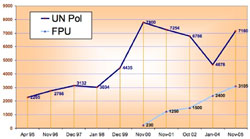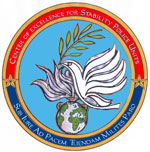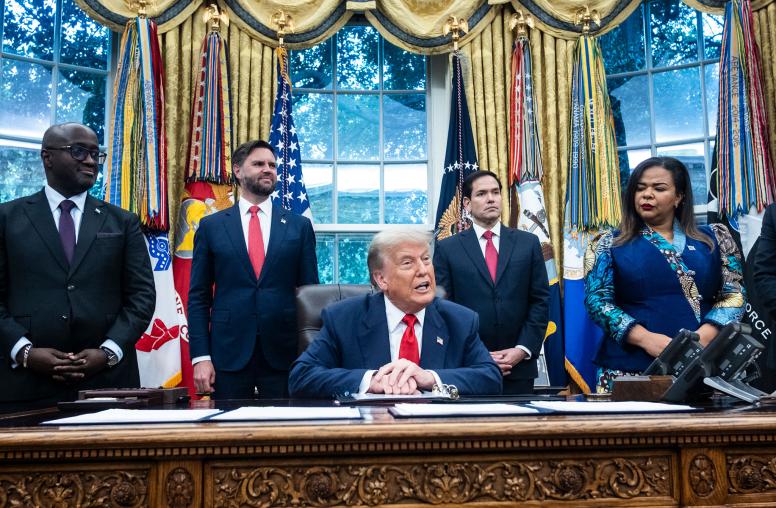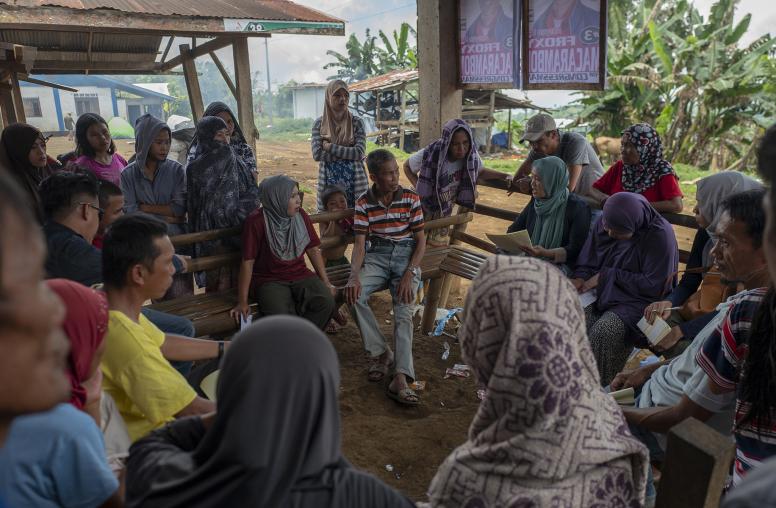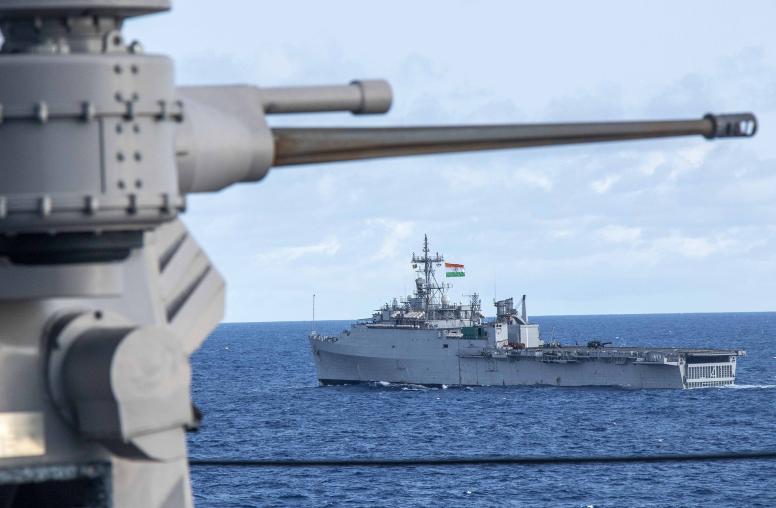Bridging the Public Security Gap: The Role of the Center of Excellence for Stability Police Units (CoESPU) in Contemporary Peace
The Role of the Center of Excellence for Stability Police Units (CoESPU) in Contemporary Peace Operations
This USIPeace Briefing explores the impetus behind the dramatic growth in the use of stability police and the central role of the Center of Excellence for Stability Police Units (CoESPU) in meeting international demand for this essential public security capability.
Editor's Note: The proposal to establish the Center of Excellence for Stability Police Units, subsequently adopted by the G-8 at the Sea Island Summit, was developed at a workshop organized by the U.S. Institute of Peace in January 2004. In May 2006, USIP conducted a workshop with the State Department's Office of the Coordinator for Stabilization and Reconstruction to examine options for the development of a U.S. capacity to mobilize and deploy stability police units for peace and stability operations.
International policing has undergone a profound transformation as a result of the introduction and widespread use of stability police units (SPUs). Since their initial deployment by NATO in Bosnia in 1998, demand for this heavy-duty policing capability has expanded to the point that SPUs now constitute almost half of international police personnel. This growth has been most dramatic in United Nations' missions. As of November 2005, the number of Formed Police Units (FPUs) fielded by the UN stood at 27, accounting for 3105 of its total of 7160 police personnel.
Source: Mark Kroeker, "United Nations Police: To Build Institutional Police Capacity in Postconflict Environments," (delivered at a conference on "Overcoming Challenges to Stability Policing," Center of Excellence for Stability Police Units, Vicenza, Italy, December 7, 2005.)
This USIPeace Briefing explores the impetus behind the dramatic growth in the use of stability police and the central role of the Center of Excellence for Stability Police Units (CoESPU) in meeting international demand for this essential public security capability.
Stability police have become an indispensable partner alongside traditional military contingents and individual police because they are vital for overcoming the public security gap that invariably confronts—and frequently confounds—peace and stability operations. SPUs have already made vital contributions to efforts to bring peace and stability in places like Bosnia, Cote d'Ivoire, Democratic Republic of the Congo, Haiti, Iraq, Kosovo, and Liberia. UN police commissioners continue to petition for additional SPUs to bolster existing missions. Future operations, such as potential UN missions in Darfur and East Timor, are likely to depend heavily on SPUs to establish and maintain public order. Thus the success of current and future missions undertaken by the UN, NATO, European Union, other international organizations, and ad hoc coalitions of the willing has become increasingly dependent on generating the required quality and quantity of SPUs.
To address the burgeoning demand for a robust and rapidly deployable policing capability, G-8 members at the Sea Island summit in June 2004 called for the creation of "an international training center that would serve as a Center of Excellence to provide training and skills for peace support operations." Accordingly, the Center of Excellence for Stability Police Units was established in Vicenza, Italy in March 2005 to serve as a doctrinal hub for stability policing and to provide training for future SPU commanders, mid-grade officers, and NCOs.
The Public Security Gap and the Role of Stability Police
Peace and stability operations have historically been plagued by dire lapses in public security, leaving an inadequate foundation for all other aspects of these missions to build upon. At the inception of most such operations, there is likely to be an immediate need to combat rampant lawlessness, revenge killings, or major civil disturbances.
Initially, the military is often the only source of order: domestic police forces in most states do not have a surplus capacity that can be readily tapped for international contingencies. Since peace missions are apt to be severely tested during the initial deployment phase, this can be a crippling deficiency.
To address this aspect of the public security gap, qualified law enforcement personnel need to be organized in rapidly deployable units. Stability police units, owing to their disciplined command and control structure and autonomous logistical support capability, are capable of rapid mobilization. Unlike individual police, moreover, they are able to survive in the anarchic conditions that often prevail during the early stages of most missions.
In addition to their rapid deployability, stability police are able to fill a critical gap in capabilities that arises between military contingents that are proficient in the use of lethal force and individual international police, who have very limited force options and may even be unarmed.
Lethal force is of limited value in preventing loss of life and destruction of property, making military units blunt instruments for coping with public disorder and lawlessness. Among the most decisive public security tasks, moreover, may be confronting threats in the form of political-criminal power structures, rogue intelligence organizations, warlords, fanatical religious groups, global terrorists, and combinations of the above. Orchestrated civil disturbances or "rent-a-mob" are typically symptoms of such underlying sources of opposition to a peace process. Individual police are not capable of handling either large-scale civil disorders or the illicit, criminalized power structures that instigate them. Bridging the gap in law enforcement capability requires proficiency in the use of less-than-lethal force, as well as in criminal intelligence and investigations.
Stability police fill this gap by performing specialized law enforcement and public order functions that require disciplined group action. This includes civil disturbance management; VIP protection; hard entry and high-risk arrest; territorial patrolling; criminal intelligence and evidence gathering; countering organized crime, terrorism, and insurgency; mobile and static security of vulnerable areas; election security; prison security; and border patrol. Stability police thus perform vital roles complementary to those of military forces and have demonstrated their effectiveness in a variety of mission areas, beginning with the Balkans.
Stability police bridge the public security gap both through timely deployment and by performing heavy-duty law enforcement functions that require proficiency in the organized use of "less-than-lethal" force. When these units are deployed in support of UN peacekeeping operations they are called Formed Police Units. With a standard strength of 125 personnel, they operate under the command of the UN police commissioner. In the NATO context stability police are called Multinational Specialized Units (MSUs). Their unit strength ranges from 250 to 600 personnel, and they operate under the operational control of the NATO force commander. The European Union has also developed a readily deployable stability policing capability. Called Integrated Police Units (IPUs), they are capable of performing executive law enforcement tasks under either the international police commissioner or senior military authority.
In addition to their vital role in establishing public security, stability police units are surprisingly cost effective. According to reimbursement formulas used by the UN, the annual costs for a 125-member formed police unit, compared with the costs of an equivalent number of troops and individual UN police, are as follows:
| Formed Police Unit (including contingent-owned equipment) | $4,189,325 |
| Military contingent (including contingent-owned equipment) | $4,827,657 |
| UN police (personnel only—not including UN-provided equipment) | $6,315,500 1 |
FPUs are thus 50% less costly than individual UN police, owing to the difference in personnel costs (The annual mission subsistence allowance for UN police is $50,000, while the annual personnel cost for each FPU member is only $13,000). Although FPUs are only slightly less expensive than an equivalent number of soldiers, they are considerably more cost-effective. While 90 percent of FPU members can be tasked to perform daily mission requirements, only about 50-60 percent of soldiers may be available for duties "outside the wire."2 Thus FPU personnel are more economical in the performance of their mandated policing functions than individual UN police and more available to perform public security-related functions than soldiers.
The Function of the Center of Excellence for Stability Police Units
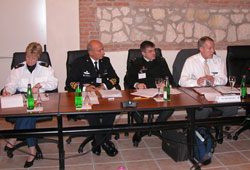
Mike Dziedzic (far right) organized a December 2005 conference at the CoESPU that addressed "Overcoming Challenges to Stability Policing" and focused on developing a doctrine for "Stability Police and the 'Intelligence-to-Evidence Gap.'"
Owing to the prominent role that SPUs have come to play in international peace missions, it is imperative that properly trained and equipped units can be generated in sufficient numbers to meet the increasing demand.
International capacity to provide SPUs, however, has been hard-pressed to keep pace. Specialized training programs are required to prepare units for the rigors of peace and stability operations, and international doctrine for their use must be developed and standardized. These are the core missions that have been assigned to the Center of Excellence for Stability Police Units. In the G-8 Action Plan on Expanding Global Capacity for Peace Support Operations, CoESPU was charged with:
- Operating training programs, including 'train the trainer' courses and pre-deployment training for specific missions; and
- Developing a common doctrine and common operational standards for employing carabinieri/gendarmerie-like forces in peace support operations.3
Funded by the Italian government with assistance from the United States under the global peace operations initiative, the intention of CoESPU is to "train the trainers" who will return to their home countries to prepare their own stability police units for international deployment.
Training:
The CoESPU curriculum covers stability policing concepts and doctrine, operational planning, international and humanitarian law, and negotiation and mediation. The faculty includes Italian carabinieri, university professors, and military officers (active and retired). All instruction is provided in English.
In December 2005, the first class graduated from CoESPU, less than 18 months after the G-8 proposed that the Center come into existence. Twenty-nine senior officers from India, Jordan, Kenya, Morocco, and Senegal completed the first high-level course. This was followed in March 2006 by graduation of 98 company-grade offices and NCOs from India, Jordan, Kenya, Morocco, Senegal and Cameroon from the mid-level course. CoESPU has an annual capacity to offer four high-level courses (40 students per class) and five mid-level courses (100 students per class), which equates to a maximum capacity of 660 students per year.
In addition, the United Nations Department of Peacekeeping Operations has teamed with CoESPU to conduct a command development seminar for its formed police unit commanders and their police commissioners. The first seminar was held in mid-March for all current FPU commanders. Future seminars are envisioned every six months so that FPU commanders can attend either prior to deployment or shortly after arrival on mission. Thus CoESPU has succeeded not only in developing and conducting a full training curriculum, but it has formed a partnership with the UN to instill the leadership and command skills required for successful international service for all current and future FPU commanders.
Doctrine:
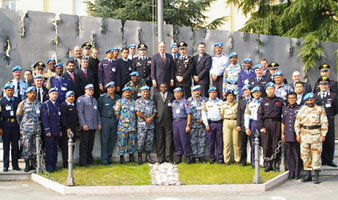
Participants of the March 13-17, 2006 Command Development Seminar for UN Formed Police Unit commanders at CoESPU. Participants included commanders of the 25 FPUs currently deployed on UN Missions, along with their Police Commissioners or Deputy Commissioners.
In April 2005, CoESPU conducted an assessment of the March 2004 riots in Kosovo (with support from the National Defense University, U.S. Army Peacekeeping and Stability Operations Institute, and the U.S. Institute of Peace).
The ensuing report, "The Future Roles for Stability Police Units," summarized current SPU doctrine, suggested how the Kosovo experience might inform that doctrine, and identified doctrinal gaps.
Bridging the intelligence-to-evidence gap—the ability to use intelligence to develop admissible evidence about violent spoilers and obstructionists—was the most critical area of doctrinal concern identified in the report. In December 2005, CoESPU organized a workshop on the role of stability police units in completing the intelligence-to-evidence sequence. The workshop was attended by representatives of the UN, NATO, and the European Union. The concepts developed at that event are currently being circulated by CoESPU among those organizations. With these activities the Center has established itself as a reputable clearinghouse for ideas across all international organizations that field SPUs, while advancing the development of common doctrine and identifying lessons for responding to emerging challenges.
Recommendations
Sustaining the Training:
The "train-the-trainer" concept presumes that, having attended CoESPU's courses, sending countries will commit themselves to use the graduates to prepare SPUs in their respective nations. A number of steps should be taken to ensure that this happens, some of which may entail a modest increase in resources available to CoESPU:
- A diplomatic "publicity campaign" should be undertaken to inform countries that have the potential to contribute SPUs to future missions about the prospects for training at CoESPU. These countries should be made a priority for training.
- Countries that send students to CoESPU for training should certify that graduates will actually return and conduct training for deployable units or be made available for international duty in some other capacity.
- Mobile assistance teams from CoESPU (MATs) should be available to support potential SPU contributing countries in establishing and conducting in-country training programs.
- MATs could be used to assist current and prospective SPU contributing countries in conducting exercises that are designed to maintain the readiness of their units and enhance their interoperability with military contingents.
Equipping New Units:
The total cost to purchase all "contingent-owned equipment" items required by the UN to outfit one FPU is a little over $6 million. At present, there is no mechanism to assist countries that have the personnel and political will to organize additional SPUs but lack the resources to procure all the necessary equipment. Even though the UN reimburses SPU contributing countries for the use of contingent-owned equipment at the rate of almost $750,000 per year through UN peacekeeping assessments, the upfront cost of equipping new FPUs is liable to be a serious limiting factor. This is a particular concern for African countries that are a priority for CoESPU training under the Global Peace Operations Initiative.
- G-8 members, other bilateral donors, and the more affluent police contributing countries should consider providing assistance to potential SPU contributing countries that lack financial resources to purchase the equipment required to meet UN standards (e.g. armored personnel carriers). One "no-cost" option would be to donate the equipment or provide up-front funding to equip units committed to serve on UN missions. The donor would be reimbursed over time by the UN from peacekeeping assessments.
Conclusion
Establishing public security is essential to the success of a peace or stability operation. Stability police units have demonstrated their critical contribution to overcoming the public security gap that inevitably arises during these missions. In a recently issued directive (DoD 3000.05), the Pentagon has explicitly stated that, "U.S. military forces shall be prepared to perform all tasks necessary to establish or maintain order when civilians cannot do so." The United States lacks gendarmerie-type police forces that are most needed for this purpose. The policy issue that remains to be answered is how the United States will close the public security gap in future peace and stability operations if coalition partners cannot be found to provide the number of stability police required.
Notes
1. Mark Kroeker, "Contingent Owned Equipment (COE) Reimbursement," briefing, conference on "Overcoming Challenges to Stability Policing," Center of Excellence for Stability Police Units, Vicenza, Italy, December 7, 2005.
2. Ibid.
3. G-8 Summit G8 Information Center, "Summit Documents: G8 Action Plan: Expanding Global Capability for Peace Support Operations," http://www.g8.utoronto.ca/summit/2004seaisland/peace.html
This USIPeace Briefing was written by Michael Dziedzic, senior program officer in the Center for Post-Conflict Peace and Stability Operations at the United States Institute of Peace, and Colonel Christine Stark, U.S. Army, Peacekeeping and Stability Operations Institute. The views expressed here are not necessarily those of USIP, which does not advocate specific policies.
The United States Institute of Peace is an independent, nonpartisan institution established and funded by Congress. Its goals are to help prevent and resolve violent international conflicts, promote post-conflict stability and development, and increase conflict management capacity, tools, and intellectual capital worldwide. The Institute does this by empowering others with knowledge, skills, and resources, as well as by directly engaging in peacebuilding efforts around the globe.
